
Consider the phrase, “Everyone is an entrepreneur.”
Do you think that’s a valid statement?
I don’t.
Not entirely, that is.
See, I don’t think everyone is an entrepreneur. However:
I DO believe everyone could benefit from having entrepreneurial thinking.
HERE’S WHY: The term “entrepreneur” comes from the French word, entreprendre, which means, “to undertake or manage some task.”
Notice it didn’t say anything about business. Or commerce. Or websites. Or running your own cupcake store.
Just a task. Just something you do. Work related or not.
So, next time you find yourself managing some task (which I imagine happens fairly often), keep these 98 entrepreneurial thoughts in mind:
– – –
1. Never stop asking, “What’s next?” When you finish one project, activity or endeavor, celebrate and then move on to the next one.
2. In January, ask yourself, “How could I spend ZERO money this year?”
3. Recognize that the only person who can make you get up, get out of bed and go to work is YOURSELF.
4. In the customer’s eyes, YOU ARE the company.
5. ASK YOURSELF DAILY: “Is what I’m doing right now consistent with my #1 goal?”
6. Speaking of things to do daily, you must market yourself every single day.
7. Ideas are your major source of income.
8. Finish this sentence: I wish there was a _______ so people wouldn’t have to ________.
9. Invest money; don’t spend it.
10. Recognize that most people do not know who you are or what you do. You need to educate them. Everyone who knows you should know what you DO, what you’re DOING and what you’ve DONE.
11. Pioneer in obscure areas.
12. With every new experience or accomplishment, ask yourself, “Now that I have this, what else does this make possible?”
13. If you’re the only employee, you need to set healthy boundaries. Because if you don’t set them, other people will set them for you. And then they will violate them. And that will set a precedent that it’s acceptable for other people to do the same. REMEMBER: Boundaries are saviors. For more, watch this NametagTV episode on boundaries!
14. ASK YOURSELF: “Is this an opportunity, or an opportunity to be used?”
15. Figure out what you know that other people find valuable. Then enable them to buy it from you.
16. Figure out why your competitors get more attention than you.
17. You are not your customer.
18. Don’t be stopped by not knowing how. Knowing why is enough. Just go. You’ll figure out the how later. Launch and learn!
19. Don’t be so in love WITH or so close TO your idea that you can’t see its weaknesses. Ask objective outsiders.
20. When you get stumped, experiment with every known fragment of your answer.
21. Make creativity your daily (er, hourly) practice. Don’t make it something you just “turn on” every once in a while. Creativity is an attitude and a lifestyle. Not a weekend warrior thing.
22. ASK YOURSELF: “Is this the most prudent use of my time right now?”
23. Operate on multiple planes of consciousness. Take on various roles of the artist, the mechanic, the CEO, the janitor and the customer service rep.
24. The more you learn, the more valuable you are.
25. The more imitable you are, the less valuable you are.
26. Diversity is equity. Are you a one trick pony?
27. Refuse to discard hunches. Your gut is smarter than you think.
28. Think ridiculously big thoughts.
29. The only way to become more successful is to get BETTER at what you do and/or, to do MORE of what you do.
30. Learn to juggle.
31. Duplicate, clone and multiply yourself. Find a way to deliver value without actually being there. Access isn’t presence.
32. Figure out at what point you’d rather grow your business than make money.
33. Figure out at what point you’d rather make a contribution than grow your business.
34. Ask yourself how YOU can do it before asking how it’s already been done.
35. Study your own discovery process.
36. If everybody loves your idea, you’re doing something wrong. Stop trying to please everybody. Stop trying to be so well rounded. Stop trying to appeal to the masses. Pick a lane, narrow your focus and start polarizing some folks. It won’t kill you. There’s a LOT of potential customers out there.
37. If everybody says you’re crazy, you might just be onto something.
38. If you’re not pissing off (some) people, you’re not doing your job.
39. If nobody’s trying to steal, copy or parody your idea, it’s probably not that good.
40. If you can’t explain your idea to a five year old, it’s not simple enough.
41. If you can’t explain your idea on the back of a business card, it’s not simple enough.
42. If you can’t explain your idea in eight words or less, it’s not simple enough.
43. If people aren’t talking about your idea, it won’t spread and therefore, won’t be successful.
44. ASK YOURSELF: If someone was going to pay you $1000 an hour, what are the questions they’ve got to ask you to get their money’s worth?
45. Make sure you are being stretched and forced to grow. Daily.
46. One of the most difficult things for an entrepreneur to do is press The Off Button. To (not) check email at 10:30 PM, for example. What about you? Are you addicted to email?
47. Going solo can become a vortex. So, be careful to walk the line between being immersed and submersed. REMEMBER: Tread, don’t drown.
48. Be the one with the most information. You will win.
49. Tooting your own horn is acceptable and necessary. Blowing your own horn? Not so much.
50. ASK YOURSELF: Are your friendships, relationships, and your emotional life suffering as a result of this task?
51. Everything you do should lead to something else you do. Make sure your ideas have movement value.
52. Continually develop options and answers. This will make the solution easier to find.
53. ASK YOURSELF: How can you do the work once and benefit many times?
54. It’s a tough road, being on your own. Sustaining ambition, commitment and dedication will be your biggest challenge. So, you better build a solid support system of multiple mentors, mastermind groups, loved ones, colleagues and other valuable relationships.
55. Execution is probably the biggest secret to all successful entrepreneurs. How do YOU turn your ideas into action? And how long will it take? Those are the big entrepreneurial questions.
56. Be careful not to spend all your time talking about your new idea. Sometimes an entrepreneur will talk the energy out of an idea then and have nothing left for action. Be careful.
57. How much could you be charging for that?
58. How often does perfection keep you from starting? Because there’s never going to be a “right” time. Just when you get there, “there” disappears. Just go, man.
59. Constantly upgrade your qualifications. In what ways are you currently obsolete?
60. State your fee confidently and then shut up. He who talks next loses.
61. Another trait of successful entrepreneurs is the ability to notice things. Trends, patterns, anomalies and the like. This helps you recognize opportunities. What are YOU noticing?
62. What’s your “currency?” Because it might not be money. It could be time with your kids, for example. And you need know what your currency is before undertaking any new endeavor.
63. Your calendar is your inventory. Protect your days.
64. You are what you charge. (Refer back to #60)
65. Listen to everybody or listen to nobody.
66. Find out where you suck. Then decide whether you need to improve in that area or hire someone else to do it for you.
67. Entrepreneurs take risks. Period. And NOT taking risks is an even BIGGER risk. So, you must learn to love your zone of discomfort.
68. Don’t say, “That’s impossible!” Instead, ask yourself, “How can I do this?”
69. Think about what you’re BUILDING, not just what you’re MANAGING.
70. Being an entrepreneur is all about freedom. Freedom to be yourself. Freedom from corporate politics. Freedom to work in your PJ’s all day. Freedom to leave work early and go to a movie on Tuesday afternoon. Freedom to do what you want, when you want it and how you want it. Freedom to lay on the couch in your pajamas all day while writing on your laptop, drinking Fennel Tea and listening to Morphine – and calling that “work.” (Hypothetically, of course.) Is what you’re doing TODAY creating more freedom TOMORROW?
71. Don’t accept the same type of assignments and clients you worked with two years ago. That means you haven’t grown much.
72. You aren’t a salesperson, a businessperson or a service provider. You are a resource. An expert. A trusted advisor.
73. Look into the future and examine what the type of people who do what you do often become. Then ask yourself if that’s the type of person you want to become.
74. Deliver insight, not just expertise.
75. Learn the rules so you know how to break them effectively. NOTE: Consider googling the rule first, just to make sure it’s not illegal.
76. Always think of yourself as self-employed. Even if you work for some huge corporate monolith. This type of thinking will help you take greater ownership and personal responsibility over your job.
77. Sell people on YOU first. Then sell them on your idea.
78. There is no finish line. You’ve never arrived. Instead, you constantly expand your skills and abilities to add more value to your self, your services and your products.
79. Be like the sharks, which start dying when they stop swimming. See, they have to ask themselves, “What’s next?” because they can’t eat, breathe or breed unless they stay in motion.
80. Screw up. Like, a lot. Love your mistakes, because mistakes reveal individuality. Also, find a way to incorporate mistakes into your work. Make them mindfully. REMEMBER: Mistakes are springboards.
81. Don’t attach yourself to a business plan. In fact, consider not even HAVING a business plan! You’d hate to limit yourself.
82. Having a MARKETING plan, on the other hand, isn’t a bad idea.
83. Having a cool company name goes a LONG way. So please, for the love of God, don’t use something unoriginal and generic like “Daniels & Associates,” “Got termites?” or “The Hagel Company.” Nobody knows the name Daniels. You don’t even HAVE any associates. And that trite “Got milk?” ripoff is about 14 years too old. You can do better. Have some fun. Get a cool company name. Good lord!
84. If you’re the kind of person that constantly needs certainty, your entrepreneurial road will be really, really rocky.
85. Being an entrepreneur isn’t a characteristic or a personality trait. It’s a way of life, a type of attitude, a style of thinking and a pattern of behavior.
86. Learn to kick your own ass, because nobody else will.
87. Focus on creativity, not efficiency. (If you want a list of the 10 best books on creativity you’ve never heard of, email [email protected] and I’ll hook you up!)
88. Don’t just think about leveraging what you have. Think also about what else you could do with what you’ve unexpectedly landed with.
89. Figure out what types of people you need to listen to, as well as what types of people (not) to listen to.
90. Criticism comes with the entrepreneurial territory. Learn to accept or discard it; or even sometimes, embrace it. And find out where you suck.
91. Questions are the most valuable resource you have. Ask lots of them. Daily.
92. As an entrepreneur, you get paid according the amount of value you deliver, not the number of hours you put in. Which means 90% of success isn’t seen. Which means you will work your ass off, and most people will only see that final 10%. Ouch. Better make sure it’s good.
93. Invest your money; don’t spend it.
94. Take your core business, build a wall around it and then go be the best.
95. Don’t waste your time dealing with potential customers and partners who (clearly) don’t know how to value you yet.
96. Define your optimal workday and workweek. Stick to it.
97. In a commoditized market, the key differentiator is service.
98. In a commoditized market, customers are just going to pick the best choice. So, if you’re not going to be the best at what you do, why even bother?
LET ME ASK YA THIS…
What are your three best practices for “thinking like an entrepreneur?”
LET ME SUGGEST THIS…
Share them here!
* * * *
Scott Ginsberg
That Guy with the Nametag
[email protected]
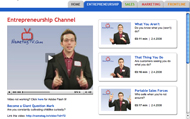 Just starting your own business?
Just starting your own business?
Tune in to The Entrepreneur Channel on NametagTV.com!
Watch video lessons on leveraging your ideas!

 For all you marketers out there, I’ve got good news and bad news.
For all you marketers out there, I’ve got good news and bad news.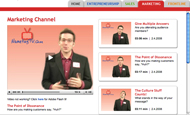 How many people blogged about YOU this week?
How many people blogged about YOU this week? 
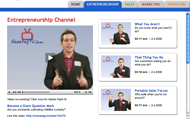 Tired of waiting for employees to come to YOU?
Tired of waiting for employees to come to YOU? Training videos putting your office to sleep?
Training videos putting your office to sleep?
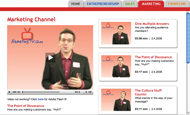 Who’s blogging about YOUR website?
Who’s blogging about YOUR website?  This week I’ve been working in The Bahamas with my friends at
This week I’ve been working in The Bahamas with my friends at 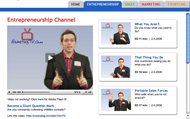 Want your staff members to open up to you?
Want your staff members to open up to you? MYTH #1: Creativity is about making something out of nothing.
MYTH #1: Creativity is about making something out of nothing.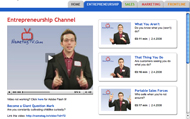 Tired of waiting around for new customers?
Tired of waiting around for new customers? Questions are differentiators.
Questions are differentiators.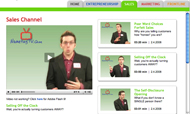 How many unsolicited referrals did YOU get this week?
How many unsolicited referrals did YOU get this week?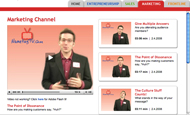 Training videos putting your staff to sleep?
Training videos putting your staff to sleep?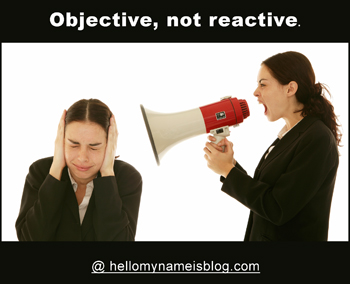
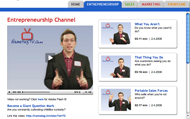 Tired of your employees avoiding you?
Tired of your employees avoiding you?